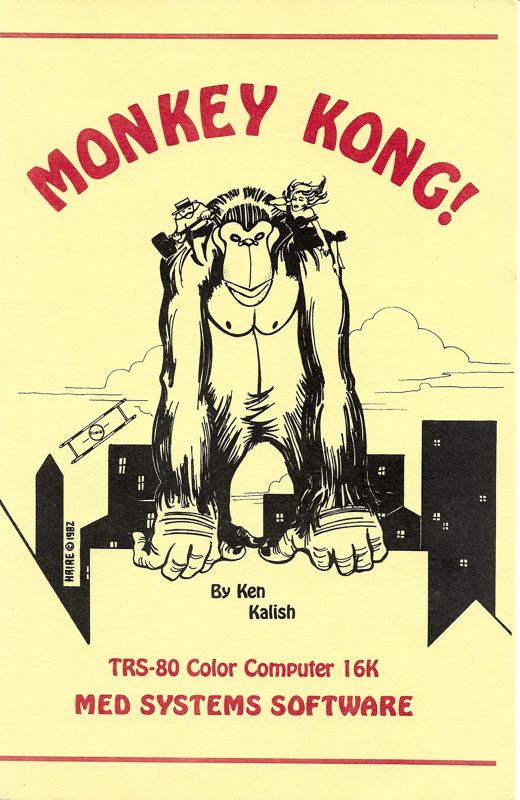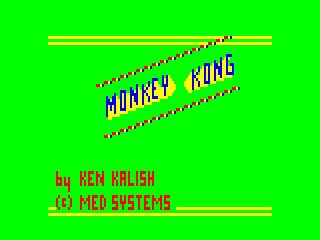Retro Replay Review
Gameplay
Monkey Kong delivers a faithful recreation of the classic barrel‐climbing action that made the original Donkey Kong so iconic. In the first stage, you guide King Cuthbert—an unmistakable Mario stand‐in—up a network of girders while dodging barrels hurled by the eponymous simian. The controls are responsive and intuitive: a single joystick or keyboard input lets you move laterally, climb ladders, and leap over obstacles with relative ease. However, mastering the timing on fast‐rolling barrels requires patience and quick reflexes.
Adding a twist to the standard formula, Monkey Kong includes hammers positioned at strategic points on the first screen. Grabbing one allows Cuthbert to smash through barrels at will, offering a surge of empowerment—but at the cost of being unable to jump or climb ladders while wielding it. This risk‐and‐reward mechanic encourages players to plan their route carefully: do you sprint through a gauntlet of barrels for high points, or play it safe and leap over them?
The second level shifts focus to the famous “rivets” screen. Here, you ascend burning girders and pop each rivet to collapse the scaffolding beneath the monkey antagonist. The fires scattered across the platforms serve as additional hazards, demanding precise movement and timing. Once all rivets are removed, gravity does the rest, sending the monkey tumbling down and clearing the way to the next loop of stages. Overall, the gameplay is simple yet addictive, relying on escalating speed and pattern memorization to keep players engaged.
Graphics
Visually, Monkey Kong runs in a modest four‐colour mode, which gives the game a distinctly retro palette reminiscent of early home‐computer titles. The backgrounds are sparse but functional, highlighting the scaffolding and ladders without unnecessary clutter. Character sprites are lifted almost directly from the original arcade source, making it instantly recognizable to fans of the genre.
While MicroDeal’s version isn’t as blatant a copy as some contemporaries, it makes no effort to disguise Cuthbert’s origins. The hero’s overalls and cap, as well as the monkey’s exaggerated expressions, are clear nods to familiar characters—which can be seen as either nostalgic homage or uninspired duplication. Animation is kept to a minimum, but the barrel‐rolling and fire sprites flicker just enough to convey motion under tight hardware constraints.
Despite its limitations, the graphics serve the gameplay well. Platforms and obstacles stand out clearly against the backdrop, and the contrasting colours allow players to spot oncoming barrels or small rivets at a glance. For enthusiasts of vintage gaming, Monkey Kong’s visuals capture the charm of early ’80s arcade ports, even if they don’t push any technical boundaries.
Story
True to its arcade roots, Monkey Kong offers virtually no narrative beyond its arcade‐style premise: a mischievous monkey has seized control of a construction site and is menacing the hero. There’s no cutscene or in‐game dialogue to flesh out motivations—just a simple setup to frame the action across two screens.
The minimal story functions purely as a backdrop for escalating platform challenges. You aren’t rescuing a princess or collecting treasure; your only goal is to outmaneuver rolling barrels and collapsing girders. This stripped‐down approach keeps the focus squarely on skillful play, but it also means that context and character development are all but nonexistent.
For many players, the lack of a deeper narrative won’t matter—Monkey Kong’s appeal lies in its pure arcade thrills. If you’re seeking a game with a compelling storyline or memorable characters, you may be left wanting. However, for those who appreciate straightforward, score‐chasing gameplay, the barebones plot is perfectly sufficient.
Overall Experience
Monkey Kong is unabashedly retro, offering two classic screens that loop indefinitely with increasing difficulty. Its simplicity is both a strength and a limitation: it’s easy to pick up and play, yet it can become repetitive if you’re craving a longer campaign or varied stage designs. The challenge curve is tuned to arcade sensibilities, rewarding pattern recognition and quick reflexes over strategic depth.
On the plus side, the game runs smoothly on modest hardware, making it accessible to a wide range of microcomputer enthusiasts. The short level roster means you can jump in for quick gaming sessions, and high‐score chasers will appreciate the relentless pressure to shave milliseconds off each run. Sound effects are minimal but effective, emphasizing jumps, barrel impacts, and rivet pops without unnecessary fanfare.
Ultimately, Monkey Kong is best enjoyed by players who relish authentic Donkey Kong clones and retro platform action. While it adds little in terms of innovation, it succeeds in capturing the spirit of early arcade ports. If you’re looking for a compact, challenging romp that evokes classic gaming nostalgia, Monkey Kong delivers a straightforward yet satisfying experience.
 Retro Replay Retro Replay gaming reviews, news, emulation, geek stuff and more!
Retro Replay Retro Replay gaming reviews, news, emulation, geek stuff and more!









Reviews
There are no reviews yet.